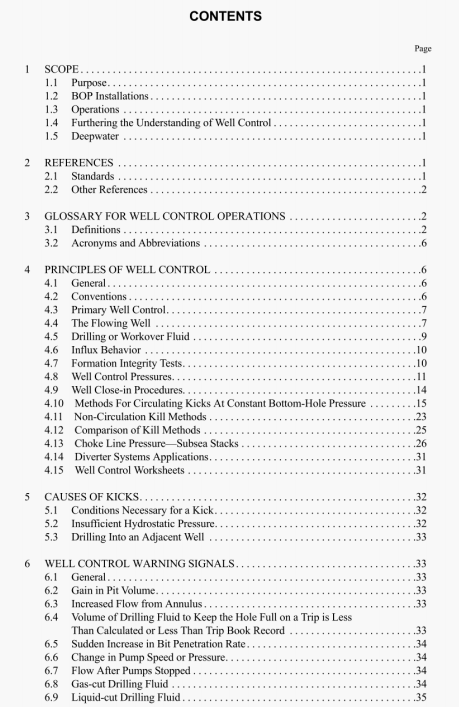API RP 59:2006 pdf download.Recommended Practice for Well Control Operations.
3.1.82 kill-rate circulating pressure: Pump pressure rcquircd to circulate kill-rate volume under non-kick conditions.
3.1.83 leak-off test: Application of pressure by superimposing a surface pressure on a fluid column in order to determine the pressure at which the exposed formation accepts whole fluid.
3.1.84 lost circulation (lost returns): The loss of whole drilling tluid to the well bore.
3.1.85 lost returns: See Lost Circulation.
3.1.86 low choke pressure procedure: Consists of circulating and weighting up the drilling fluid, both at the maximum rates, while holding the maximum allowable casing pressure on the choke.
3.1.87 lubrication: Alternately pumping a relatively small volume of fluid into a closed well bore system and waiting for the fluid to fall toward the bottom of the well.
3.1.88 marine riser system: The extension of the well bore from the subsea HOP stack to the tloating drilling vessel which provides for fluid returns to the drilling vessel, supports the choke, kill, and control lines, guides tools into the well, and serves as a running string for the BOP stack.
3.1.89 mud-gas separator: A vessel for removing free gas from the drilling fluid returns.
3.1.90 normal pressure: Formation pressure equal to the pressure exerted by a vertical column of water with salinity normal for the geographic area.
3.1.91 overbalance: The amount by which pressure exerted by the hydrostatic head of fluid in the well bore exceeds formation pressure.
3.1.92 pack-off or stripper: A device with an elasiomer packing element that depends on pressure below the packing to effect a seal in the annulus. Used primarily to run or pull pipe under low or moderate pressures. This device is not dependable for service under high differential pressures.
3.1.93 pipe rams: Rams hose ends are contoured to seal around pipe to close the annular space. Separate rams are necessary for each size (outside diameter) pipe in use.
3.1.94 pore pressure (formation pressure): Pressure exerted by the fluids within the pore space of a formation.
3.1.95 pressure gradient, normal: The normal lressure divided by true vertical depth.
3.1.97 Productivity Index (PI):The Pl represents onepoint on an inflow performance curve (IPR) and is defined asthe well flow in barrels per day per psi pressure drop.
3.1.98 Remotelyoperated Vehicle(RoV):Anunmanned vehicle for offshore subsea use.
3.1.99 replacement: The process whereby a volume offluid equal to the volume of steel in tubulars and tools with-drawn from the well bore is returned to the well bore.
3.1.100rotating head or rotating drilling head: Arotating, low pressure sealing device used in drilling opera-tions utilizing air,gas,or foam (or any other drilling fluidwhose hydrostatic pressure is less than the formation pres-sure) to seal around the drill stem above the top of the BOPstack.
3.1.101rotating stripper head: A sealing deviceinstalled above the BOPs and used to close the annular spaceabout the drill pipe or kelly when pulling or running pipeunder pressure.
3.1.102rotary table: A device through which passes thebit and drill string and that transmits rotational action to thekelly.
3.1.103safety factor: In the context of this publication,an incremental increase in drilling fluid density beyond thedrilling fluid density indicated by calculations to be needed tocontain a kicking formation.
3.1.104saltwater flow: An influx of formation saltwatcrinto the well bore.
API RP 59:2006 pdf download
